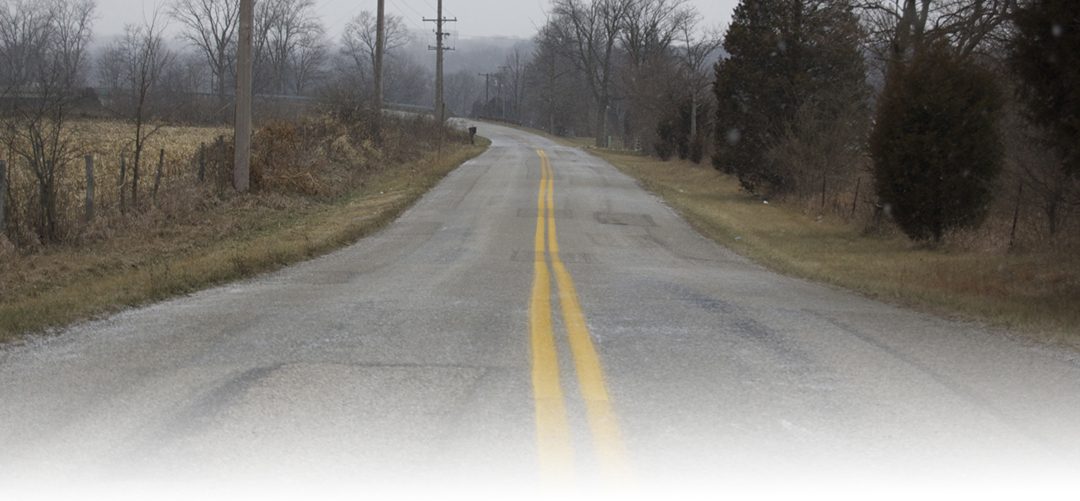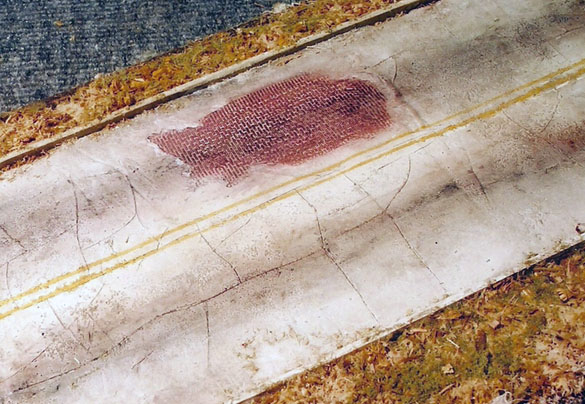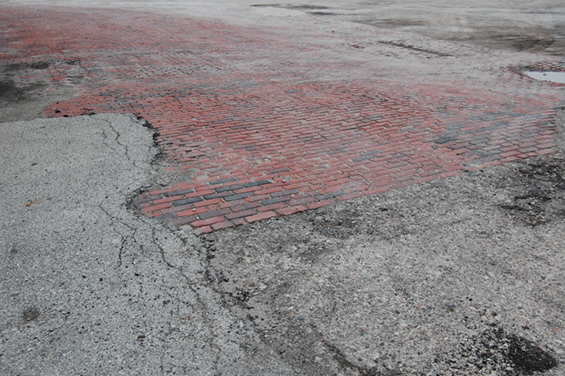
Modeling Roads And Pavement
When I removed the curve to the staging cassette, Canal Road also disappeared. That leaves only Mill Street, the crumbling platform by the Pole Track and the graveled access road behind the yard for vehicles. I don’t intend to add more pavement to the layout but I will have paved areas on the P48 display to contend with. In fact, much of the display will feature a variety of pavement types, from old broken concrete to even older brick pavers. Roads tend to take a back seat to the more desirable rail-oriented features but they’re important to the overall scene because when one aspect is out of balance with the rest, the credibility we strive so hard to achieve suffers. I like to mimic the actual materials in my modeling, so plaster is the medium of choice for masonry effects. I used a pre-mixed drywall joint compound for Mill Street, troweling it out with a wide putty knife between stripwood formers. Applied as a thick coat, it shrinks and cracks in a natural way as it dries. I take advantage of this by leaving the cracks to represent older pavement and only fill large, unsightly cracks as needed. The others are blended in by painting the raw plaster with an all purpose primer before coloring. I sprinkle on very fine sand before the joint compound dries and lightly roll it in with a piece of dowel rod. I have to wait until the compound is firm enough, otherwise I’ll ruin it and have to start over. The sand gives a nice texture not unlike a macadam tar and gravel road.
Sample road made of joint compound with a Plastruct brick sheet insert. Painted with acrylic washes and a final rubbing with dirt and chalk dust for road grime and to blend the colors. The curbs are styrene strip.

This older street is a mix of brick pavement with many asphalt patches made over the years. It’s a great modeling opportunity for a close -up scene.

Since people will have a close-up view of the module, I want to go all out on the pavement texture and detailing. I picture this area in one of two ways: as track buried in the street or as a paved area next to the siding. I want viewers to see the potential of track modeling in quarter-inch scale, so I don’t want to completely bury all the track under concrete and brick. I’m still experimenting with the scene and haven’t decided on the final composition. I’m representing an older industrial scene and I’m thinking that more brick pavement than concrete is the way to go. Richmond has several older brick streets in the industrial areas near the tracks and the street I’m using for inspiration is a wonderful mix of concrete and old brick (second photo above). For this I’ll use plastic brick sheets from Plastruct or JTT Products. I’ve been stockpiling both since I also have a large warehouse flat to build for the display. When I finalize the scene, I’ll certainly share the progress here. For now I’ve done some very crude mockups in the cabinet and like what I see. I think it will shape up nicely. More to come soon, including ways to build structures that measure out in actual feet. Regards, Mike
Mike,
For large structures have you considered using 1/8″ or 1/16″ styrene? I bought a couple of 4’x8′ sheets in both sizes from a local plastic supplier (they had down to 0.010″), and have used those as the base for a large building (6’x7′). The 1/16″ would be lighter for the modules, but it might need more bracing. The other common substructure in large scale is PVC boards. Light, and carve-able, and actually waterproof.
Craig
Hi Craig,
I hadn’t thought of styrene that thick. My flat will be four feet long by 20-21 inches high. I considered my stock of 40mil sheets but they would need a lot of bracing. Right now I’m leaning toward high quality quarter-inch plywood for the substructure. Along with good bracing, I plan to thoroughly seal it with a couple coats of poly as insurance against movement (well, severe movement that is). It should work okay and I don’t have to worry about exposure to the weather like you do. I might also look at thin MDF if I can find a local source of quality material.
Regards,
Mike
I sure like how well this turned out.
/chris